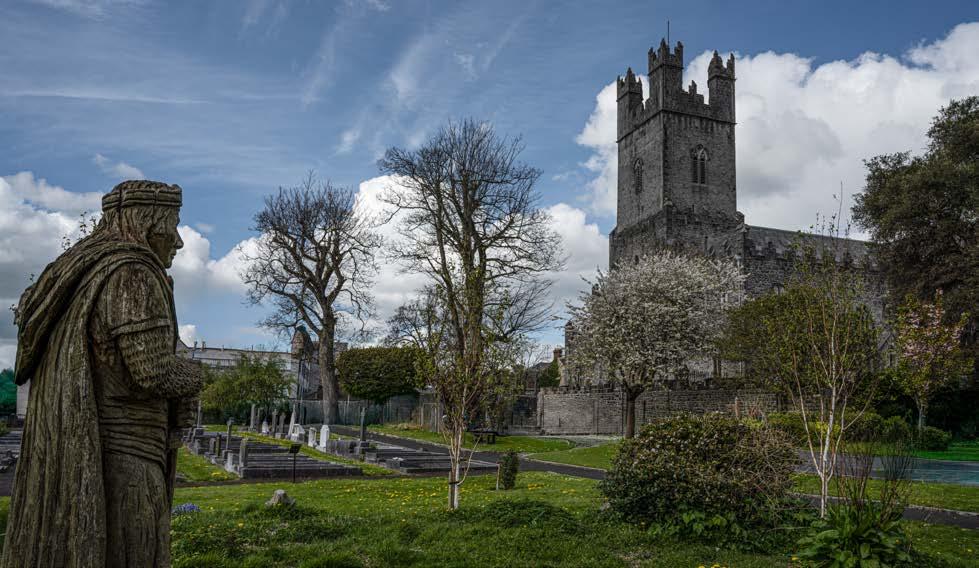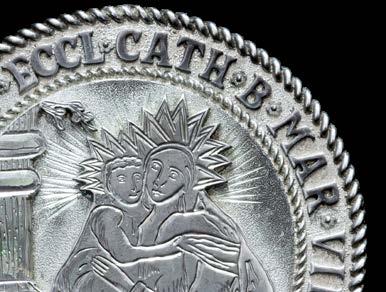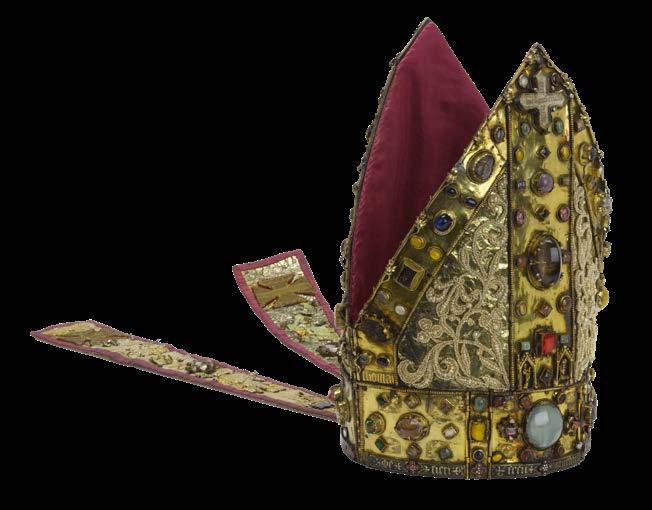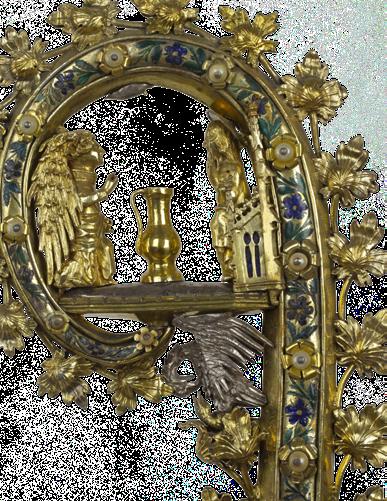






Any Bishop, certainly in the Anglican context, writes a foreword as a guide to ‘his’ or ‘her’ cathedral with a certain trepidation. The Dean, after all, is the person really in charge within its walls. The Bishop may make liturgical appearances on certain occasions, and the building has its very name because of the presence of the Bishop’s cathedra, or teaching chair (see p.13 for image). That said, the Bishop is always, to a certain extent, a visitor, mindful that, when newly arriving in the diocese, it is necessary literally to hammer on the West Door with the crosier and beseech the Dean and the Chapter to be let in.
It is precisely because my role never allows me to lose the eye of the visitor that I welcome this guide so warmly. I always try to approach the glories of Saint Mary’s with a fresh eye. Its interior light is never the same on two days of the year, and there is always some new detail to be noticed. Those who (like me) are less challenged by the relentless demands of its maintenance are able to sit back in the balm of its holiness. I therefore commend this excellent guide, a true labour of love on the part of its compilers, to my fellow visitors. Enjoy this amazing building, let it even allow you to fall to your knees, and go on your way refreshed and rejoicing. And be thankful (again like me) that the Dean, Chapter, Vestry and staff care for it so splendidly, and that they were thrilled today to let you in, as yet another welcome pilgrim who came expectantly knocking!
The Right Rev’d Michael A.J. Burrows Bishop of Limerick


The stones of Saint Mary’s Cathedral, Limerick are a record of its long and fascinating history. It is believed to be one of the first churches in Ireland designed and purposely built as a ‘great cathedral’, and it has continued in this use as a place of worship virtually uninterrupted over the course of more than 850 years. As Thomas Westropp wrote of the Cathedral, in 1898, ‘[I]ts confused architecture recall[s] nearly every period of the seven centuries that have passed since its foundations were laid.’
Dedicated to the Blessed Virgin Mary, the Cathedral stands proudly on the highest point of King’s Island at the heart
of the medieval city of Limerick. For over nine centuries, its venerable walls have witnessed the development of Limerick City from its Hiberno-Norse origins through successive invasions by Irish kings and Anglo-Norman invaders, as well as the tumultuous period of the Reformation in the 16th century. It endured also the bloody sieges of Limerick by Cromwell and William of Orange in the 17th century that gave the city its motto, Urbs Antiqua Fuit Asperrima Belli, ‘an ancient city wellversed in the art of war’.
Its original foundation can be dated to 1111, during the episcopate of Bishop Gille, when Limerick was ruled by King



Murtaugh O’Brien, a descendant of Brian Boru. That year, Gille acted as Legate to Pope Paschal II at the Synod of Ráth Breasail, which divided Ireland into modern dioceses, including the See of Limerick. It was decreed that the church of Saint Mary would become the principal church of the Diocese of Limerick.
The great Romanesque West Door may date from this period, though archaeological excavations show that the sandstone doorway is not in its original location, as earlier burials were
uncovered beneath it. Excavations also discovered earlier church foundations at the crossing of the south transept, and the skewed alignment of the south aisle of the modern Cathedral may be a remnant of the foundations of the original Cathedral.
In the mid- to late 12th century Saint Mary’s was completely rebuilt and enlarged considerably in the Burgundian style favoured by the Cistercian order, and the traditional foundation date for the Cathedral is given as 1168. The Cathedral was re-constructed in a cruciform plan,
The treasury has the most important collection of 17th- and 18th-century locally made Limerick silver. The importance is highlighted in that many of the silversmiths and donor families were baptised, married and buried either in Saint Mary’s, Saint Munchin’s or Saint John’s Churches. Saint Mary’s was also the place of worship for many of these silversmiths and donors. The treasury is a great source of information to researchers in identifying the makers and their marks, and has silver by prominent 17th-century Dublin silversmiths and an example of a 17th-century unrecorded London

Ɉ The Seal of the Dean and Chapter (2017)
This piece was made by Gleeson Goldsmiths in Shannon, Co. Clare for Dean Sloane and is worn by the Dean of Limerick.
silversmith. There are a number of pieces of church plate that belonged to other churches in the diocese and which are now deconsecrated. There are also examples of 17th-century church plate by two eminent Limerick silversmiths: John Bucknor, the first Limerick silversmith to use a punch for his maker’s mark, ‘I.B.’ flanged by three stars and a punch for the ‘Town Mark’ (a castle) gateway between two towers in the 1660s; and James Robinson, whose maker’s mark was ‘I.R.’ in script conjoined, an eight-pointed star and a castle, all in irregular punches.

Ɉ The Saint Mary’s Bread Plate (1676) Silver circular plain dish-shaped bread plate with reeded border. Diameter: 25.4cm. Weight: 15oz. Mark: Maker’s mark ‘P.P.’ in a shield; Leopard’s head crowned; Lion passant; Date letter ‘P’ for 1672–3.

An unrecorded London silversmith.
Inscription: ‘Ecclesiae Cathdrali Stae Mariae Virginis Limericensis’, D-D. I-H. 1676’ (the initials possibly refer to the donor(s)).

Ɉ Paten by John Bucknor (c.1665)
Plain circular dis-shaped paten with a wide rim. No inscription.

Ɉ The Smith Flagon (1711)
A large silver flagon with tapered cylindrical body on a moulded foot with an applied rim on top and an applied reeded band above the foot. The hollow tapering ‘S’ scroll handle is decorated on top with an applied ‘rat-tail’ and a raised thumbpiece below the hinge in the form of a double corkscrew.
Maker: James Robinson, Limerick ‘J.R.’ monogram in a shield (1679–1715).
Inscription: ‘The Gift of Mrs. Dorathea Smith to the Church of St. Munchins May 1st 1711’.
Dorathea Smith was the wife of Thomas Smith, Bishop of Limerick (1695–1715). This flagon was donated three months before she died on 6 August 1711. She is buried in Saint Munchin’s Church, where there is a monument erected to her memory over the Smith family vault.

Ɉ Marsh Communion Cup (1671)
Silver communion cup with a deep beaker-shaped tapered bowl on a spreading trumpet foot which is soldered to the bowl. It has decoration of pointillé work around both the bowl and the foot. Inscription: ‘Sacris Sti Munchini Limeric D Dq Humillima Jesu Serva Maria Marsh 1671’.
Maria Marsh was the daughter of Jeremy Taylor, Bishop of Down, Conor and Dromore (1661–7). She married Francis Marsh, Bishop of Limerick (1667–73) and Archbishop of Dublin (1682–93). He died in 1693 and is buried in Christ Church Cathedral, Dublin.

Ɉ Plate (1795)
Silver bread plate inscribed ‘St Mary’s Limerick 1795’.

Ɉ The Williamson Flagon (c.1700)
This silver flagon has a hollow ‘S’ scroll handle, raised shell thumbpiece, domed lid and trumpet-shaped spreading foot.
Maker’s mark: ‘I.R.’ conjoined script for James Robinson, Limerick silversmith.
Engraved with the Arms of Williamson impaling Lennox surmounted by a scroll bearing the motto ‘SUB UMBRA ALA RVM TUARUM’.
Inscription: ‘Ex Dono Josephi Williamson Equitis Aurati Ecclesiae Cathedrali Beatae Mariae Virginis Limericencis’.
Sir Joseph Williamson sat in the Irish House of Parliament (1692–5) and as an MP for Co. Clare and for Limerick until 1699. He married Catherine Stuart (Baroness Clifton), widow of Henry O’Brien, Lord Ibrackan.
Williamson died in 1701 and was buried in Westminster Abbey, where he was joined by his wife a year later.



Ɉ The Cornelius O’Dea Mitre and Crosier Cornelius O’Dea was consecrated Bishop of Limerick in 1400 and resigned in 1426. He died in 1434 and was buried in Saint Mary’s Cathedral. The jewelled mitre and crosier, mostly made of silver, were made to the order of Cornelius O’Dea in 1418. Only the mitre bears the engraved signature of the maker: ‘Thomas O’Carryd, artifex facients.’ Thomas O’Carryd may be Thomas O’Carty,
who is mentioned by Gilbert in ‘The Callender of Ancient Records of Dublin’ as a goldsmith in that city in 1418. They are regarded as the greatest medieval treasures of Limerick, and their survival during the sieges and turmoil of the city is extraordinary. The O’Dea Mitre and Crosier are on display nearby in the Hunt Museum, Rutland Street, Limerick.


Many of the Cathedral’s monuments are in memory of loved ones sadly lost in wars all over the world. Others commemorate the good deeds of benefactors who have passed through this ancient place over the centuries.
In all, there are over 80 monuments on the walls and floors of the Cathedral, including ones memorialising the O’Briens, founders of this great building, and the Barringtons, who founded Barrington’s Hospital and built Glenstal Castle (now Glenstal Abbey). The earliest memorial to the Barrington family is located in the graveyard and dedicated to Francis Barrington, who died in 1683. It is generally accepted that he was the father of Samuel Barrington, the clock and chime maker. There is also a monument in memory of Samuel Barrington: a small,
discreet stone on the south-west pillar dated 1693.
There are nine memorials to the Maunsell family. Robert and his brother Thomas Maunsell were the founders of the Maunsell Bank in 1789. Robert’s bust is on a pedestal on the south-east pillar of the nave in the Cathedral. Another member of the family founded an Anglican nunnery, while others are commemorated for their involvement with the military.
The fine statue of Bishop Jebb was executed by the eminent sculptor Edward Hodges Bailey. Another sculpture of interest is the Westropp Reredos on the east wall of the south transept (Saint James’ Chapel), which had been exhibited at the 1862 International Exhibition. It consists of a triple arcade, where the centre panel is a representation of the Resurrection, and on

The Westropp Reredos.
The Cathedral Tower is home to the famous bells of Saint Mary’s, which have witnessed all the changes of Limerick’s chaotic history, pealing forth in joy and in sorrow, for festival and funeral, bringing pleasure or consolation to all with their mellow tones.
The Cathedral bells hold a special place in the hearts of all Limerick people, as their distinctive sound can be heard every Sunday morning, calling parishioners to worship. But the bells are also rung for many civic and cultural events. One of the old customs is for the bells of Saint Mary’s to ring in the New Year. Late on New Year’s Eve the ringers ascend the tower, while citizens of the city gather in
the streets below to await the tenor bell tolling the 12 strokes of midnight, before being joined by the remaining bells.
The bells are rung by a dedicated group of ringers, who have won many awards at bell-ringing competitions over the years. The ringers are rightly proud not only of their skills but of their ecumenical traditions, as they and the ringers of Mount Saint Alphonsus have assisted each other in ringing bells, long before ecumenism was developed.
The tower, located at the Cathedral’s western end, dates from the 15th century, as does the belfry, which contains the famous eight bells. The first reference to the Cathedral bells dates from the time



Ɉ To your right is the head of a young man with a distinctive headdress fashionable in the 15th century, the chaperon, with the hair piled up on top of the head and covered with a twisted hood.

Ɉ Moving one further stall to your right you see another fictional monster, the Manticora, thought to have the face of a human, the body of a lion, the wings of an eagle and the tail of a scorpion. It supposedly devoured human flesh.

Ɉ The final carving to your right at the end of the row of stalls is another human head, supposedly a representation of King Henry IV, who had reigned earlier in the 15th century.


There are many more, so go feast your eyes and let your imagination run riot as you explore these timber jewels from the heritage of Limerick.

Several choral scholars have been students on the unique UL Master’s course in Ritual Chant and Song at IWAMD, and this creates a direct link back to the medieval music that would have been sung in services since the earliest years of the Cathedral’s history.
The first indications of liturgical practice in Saint Mary’s occur in the constitutions establishing the chapter of canons enacted
Sacred choral music has been sung in Saint Mary’s Cathedral for the past eight centuries, a tradition that continues to the present day. The current cathedral choir is made up of a number of secondary school and third level students (choral scholars), who are supported by professional singers (vicars choral) and some volunteers. In recent years it has been possible to establish fruitful links with the Limerick School of Music, the Irish World Academy of Music and Dance (IWAMD, at the University of Limerick) and Mary Immaculate College.



Franklin, who later moved on to be organist of Saint Columb’s Cathedral, Derry. Indeed, two organists covered nearly a whole century between them: George Frederick Handel Rogers (for whom there is a memorial plaque in the Cathedral, see p.19) was at Saint Mary’s from c.1838 to 1885, and he was succeeded by Mr Muspratt.
from 1748 to 2004, including several generations of the Osborne family. Between them, four members of this family were organists at Saint Mary’s from 1748 to c.1837. George William Osborne (organist 1799–c.1833) was father to the most celebrated member of the family, George Alexander, who was to become renowned not only as an organist but also as a pianist and composer, and counted Berlioz and Chopin amongst his friends. Subsequent organists included a former assistant organist of Westminster Abbey, Frank Muspratt, and Michael
In the years following Disestablishment the choir benefited from a bequest made by Bishop Charles Graves. It is recorded ‘that in accordance with the traditional usage of many years full public choral services have been and now are duly and reverently conducted (after the use of the Church of Ireland)’.
Those currently entrusted with responsibility for the music and liturgy seek to continue in this spirit. In addition to singing at the weekly services, the cathedral choir also takes part in concerts and performances away from Saint Mary’s. There is a regular series of lunchtime concerts at the Cathedral, and together with other concerts and events , the musical ministry of Saint Mary’s reaches far out into the ancient city and county of Limerick.


People are at the heart of all the Cathedral’s activities – worshippers, benefactors, tourists, volunteers, clergy. Each in their own unique way have and continue to make an impression on Saint Mary’s. Over the centuries many people, both international and local, are connected to Saint Mary’s Cathedral, some incidentally and others through longevity, within the wider Limerick and Irish context. Here we give a small glimpse into the lives of some of those who have made their mark in this wonderful place.
Ɉ The Very Reverend Sandra Pragnell was the first female to hold the post as the 62nd Dean of Saint Mary’s Cathedral from 2012 to 2017. From Southampton, England, she moved to Ireland in 1994. Before coming to Limerick, she was rector of a parish in Dundalk, Co. Louth.
Ɉ Lady Victoria Brady (née Pery) was born in 1893, to William Pery, 4th Earl of Limerick, and May Pery, Countess of Limerick. Victoria was a pioneering aviator, performing five ‘loop the loop’ flights at Hendon aerodrome alongside
Gustav Hamel, a British aviator. She married James Brady, an American, with whom she had two children. She died in 1918 of influenza.
Ɉ Catherine O’Brien was born in 1881 in Co. Clare. Having trained at the Dublin Metropolitan School of Art, she designed two windows in Saint Catherine’s Chapel. She was part of the Irish An Túr Gloine (Tower of Glass) movement, a stained glass co-operative. Other of her works are to be seen in churches around Ireland.

Ɉ Frances Condell was the first female Mayor of Limerick, 1962–4. She worked diligently to ensure US President John F. Kennedy’s visit to Limerick in 1963. He commented on her witty speech, and indeed she spoke eloquently on his death later that year. She retired from city council life after her second term, devoting her time to causes close to her heart in the city. Condell Road, on the west side of the River Shannon, is named after her. She died in 1986 and is buried in the Cathedral’s graveyard.
Ɉ Florence Nightingale contributed financially to the stained-glass window created in memory of Augustus Stafford O’Brien, Member of Parliament.
Ɉ Robert von Ranke Graves (1895–1985), known as one of the war poets, has connections to Saint Mary’s through both his father and grandfather. His father, Alfred Percival Graves, was prominent in the Gaelic Revival. His grandfather, Charles Graves, Bishop of Limerick 1866–99, is interred in the Cathedral grounds.
Frances Condell with President Kennedy in 1963.
Ɉ Willie Pearse, a mason and sculptor, created the reredos behind the high altar. In it, Jesus Christ is depicted as the Prophet, Priest and Shepherd of His flock. Willie was the brother of Patrick Pearse, teacher and leader of the Easter Rising 1916, for which he was executed.
Ɉ Micheál Ó Súilleabháin (1950–2018), noted composer and pianist, founded the Irish World Academy of Music & Dance at the University of Limerick in 1994. He performed in the Cathedral on many occasions.
Ɉ Catherine Hayes (1818–1861) was born in Limerick and baptised in Saint Mary’s. The Bishop of Limerick at the time, Edmund Knox, noted her singing talent and arranged for her tuition in Dublin. She did further training in Milan, making her debut in Marseille, France. She was the first Irish woman to sing in the Royal Opera Covent Garden, London and at La Scala, Milan. She toured extensively in the Americas and the Pacific region.



The history of a place is perhaps most evident in the memorials and tributes to those who passed through it. This is certainly the case when one examines the centuries-old graveyard that surrounds Saint Mary’s. The graveyard can be divided into three historic periods: the upper sections within the graveyard walls, and within the immediate vicinity of the Cathedral (c.1600–c.1910); the lower section parallel to Bridge Street (c.1880–c.1940); and the two lower sections parallel to Merchant’s Quay (from c .1900). The surviving burial registers at Saint Mary’s date from c.1700. Since then, over 13,000 burials have been recorded here.
Before the expansion of the grounds surrounding Saint Mary’s, burials would have primarily taken place in burial vaults and graves inside the Cathedral itself. Being buried inside the Cathedral was
an honour bestowed only on certain individuals – wealthy parishioners and patrons, members of the clergy, and Bishops. Examples of these burial monuments can be seen inside the Cathedral, and around the Shaw Memorial, to the left before the West Door entrance. Walking around the graveyard, one walks through some of the original streets and lanes of medieval Limerick. Names like Grid Iron Lane and Bachelor’s Walk now form part of the paths and walkways around the grounds of the Cathedral. Before the expansion of the graveyard in the 19th century, many buildings stood on the land surrounding the Cathedral. Today, there is little trace of these structures, apart from two points of interest.
The present surviving remains of the façade of the Limerick City Exchange (a covered market place and home to
Originally, stained-glass windows in a church or a cathedral were for teaching and reminding the people of Bible stories. Over the centuries this continued, with the added sponsorship of prominent families who worshipped in the churches. Saint Mary’s Cathedral has many fine windows which were financed by important families in Limerick City and the surrounding area.
Ɉ Westropp Window (or Old Testament Window) (south transept)
The five lights, or panels, in this spectacular window show some of the doings of Noah, Abraham, Moses, David and Solomon. This one is of interest to children in particular, as it includes some of the animals from Noah’s Ark.





Ɉ Edwards Window (beside Saint George’s Chapel)
This window depicts the Crucifixion (He was delivered for our offences) and the Resurrection (And was raised for our Justification) in memory of Isabella Edwards, wife of Rev. Arthur Edwards, Vicar Choral of Saint Mary’s. This in itself is unusual in a Church of Ireland cathedral, as it depicts the crucified Jesus Christ.

Ɉ Glentworth Windows (Saint George’s Chapel) These two windows depict scriptural scenes, including the Crucifixion and the Resurrection. The three-light window shows the Agony in the Garden, the Transfiguration, the Scourging and Christ Bearing the Cross. The window is presumed to be in memory of one of the Earls of Limerick or some member of the Pery family. The two-light window is in memory of Edmund, Viscount Glentworth (I heard a voice from heaven saying: Blessed are the dead who die in the Lord).



The Dean expresses his thanks to all those who contributed towards the production of this booklet: Rosalind Stevenson (Editor, The People, The Windows), Bishop Michael Burrows (Foreword and Misericords), John Elliott (A Brief History of an Ancient Cathedral), Andrea Brislane (A Brief History of an Ancient Cathedral), Jim Noonan (The Treasury), Noreen Ellerker (Monuments), Kieron Brislane (Bells), Peter Barley (Music), Craig Copley Brown (The Graveyard). Thanks also to John Holmes for his photography, and to the team in Kulturalis for their guidance and help.
All photographs by John Holmes, except for p.14, which is Courtesy the National Library of Ireland, and images on p.16 © Diocese of Limerick. O’Dea mitre and crosier are displayed in the Hunt Museum, Limerick on behalf of the diocese.
This edition © Kulturalis Ltd, 2026
Texts © the Dean and Chapter of Saint Mary’s Cathedral, Limerick, 2026. Illustrations © the Dean and Chapter of Saint Mary’s Cathedral, Limerick, 2026, unless otherwise stated.
The author has asserted their rights under the Copyright, Designs and Patents Act, 1988, to be identified as the author of this work.
First published in 2026 by Kulturalis Ltd 14 Old Queen Street London SW1H 9HP United Kingdom www.kulturalis.com
ISBN 978-1-83636-015-5
Project manager: Neil Burkey Designer: Adrian Hunt
Printed and bound in Turkey Reproduction by Opero, Verona 10 9 8 7 6 5 4 3 2 1
EU GPSR Authorised Representative: EASY ACCESS SYSTEM EUROPE OÜ, Mustamäe tee 50, 10621, TALLINN, Estonia email: info@easproject.org
All rights reserved. No part of this book may be reproduced, stored in a retrieval system or transmitted in any form or by any means electronic, mechanical, photocopying, recording or otherwise, without the written permission of the author and publisher.
Every effort has been made to acknowledge correct copyright of images where applicable. Any errors or omissions are unintentional and should be notified to the publisher, who will arrange for corrections to appear in any future editions.
British Library Cataloguing in Publication Data. A catalogue record for this book is available from the British Library.